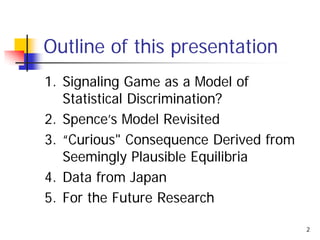Can the Signaling Game Serve as a Model of Statistical Discrimination?
- 1. 1 Can the Signaling Game Serve as a Model of Statistical Discrimination? Kunihiro Kimura (Tohoku University, JAPAN) Rationality and Society Pre-Conference American Sociological Association August 9, 2013, New York, USA
- 2. Outline of this presentation 1. Signaling Game as a Model of Statistical Discrimination? 2. SpenceŌĆÖs Model Revisited 3. ŌĆ£Curious" Consequence Derived from Seemingly Plausible Equilibria 4. Data from Japan 5. For the Future Research 2
- 3. 1. Signaling Game as a Model of Statistical Discrimination? ’ü« Aigner and Cain (1977) ’ü« ŌĆ£In SpenceŌĆÖs model of market signaling, [statistical] discrimination may result ŌĆ”ŌĆØ ’ü« But ŌĆ£final judgments [on SpenceŌĆÖs model] should be withheld.ŌĆØ 3
- 4. 1. Signaling Game as a Model of Statistical Discrimination? ’ü« Arai (1995) ’ü« ŌĆ£ŌĆ” statistical discrimination arises when employers have imperfect information ŌĆ”ŌĆØ ’ü« ŌĆ£ŌĆ” employers determine hiring, job allocations, wages, promotions, etc., ŌĆ” on the basis of statistical attributes ŌĆ” of the individualŌĆÖs group.ŌĆØ 4
- 5. 1. Signaling Game as a Model of Statistical Discrimination? ’ü« Arai (1995) [continued] ’ü« ŌĆ£Groups are classified ŌĆ” according to characteristics such as race, sex, and origin, ŌĆ”ŌĆØ ’ü« ŌĆ£These characteristics are close to SpenceŌĆÖs indexes.ŌĆØ ’ü« Signal: education (years of schooling) ’ü« Index: ethnicity, gender, class origin, etc. 5
- 6. 1. Signaling Game as a Model of Statistical Discrimination? ’ü« Can the signaling game (with an ŌĆ£indexŌĆØ) really serve as a model of statistical discrimination? 6
- 7. 1. Signaling Game as a Model of Statistical Discrimination? ’ü« Can the signaling game (with an ŌĆ£indexŌĆØ) really serve as a model of statistical discrimination? ’ü« NO! 7
- 8. 1. Signaling Game as a Model of Statistical Discrimination? ’ü« Can the signaling game (with an ŌĆ£indexŌĆØ) really serve as a model of statistical discrimination? ’ü« NO! ’ü« ŌĆ£CuriousŌĆØ consequence derived from seemingly plausible equilibria for SpenceŌĆÖs model. 8
- 9. 2. SpenceŌĆÖs Model Revisited Gender Productivity Proportion of own Group Education Costs Male 1 q y Male 2 1 ŌłÆ q y/2 Female 1 q 2y Female 2 1 ŌłÆ q y 9
- 10. 10 C1 WM(y) C2 1 yM 2 y 2 1
- 11. 11 C1 WF(y) C2 .5 yF 1 y 2 1
- 12. 2. SpenceŌĆÖs Model Revisited ’ü« One type of signaling equilibria: ’ü« where 1 < yM* < 2 and 0.5 < yF* < 1 12 Male Female Productivity Wage Return Wage Return 1 1 1 1 1 2 2 1 ŌłÆ yM*/2 2 1 ŌłÆ yF*
- 13. 2. SpenceŌĆÖs Model Revisited ’ü« One type of signaling equilibria: ’ü« where 1 < yM* < 2 and 0.5 < yF* < 1 13 Male Female Productivity Wage Return Wage Return 1 1 1 1 1 2 2 1 ŌłÆ yM*/2 2 1 ŌłÆ yF*
- 14. 3. ŌĆ£Curious" Consequence ’ü« EmployersŌĆÖ beliefs: ’ü« Educational costs (including the psychological one) for women are greater than those for men. ’ü« Women with shorter years of education have the same productivity as men with longer years of education. ’ü« Therefore, employers would offer the same wage for the men and the women. 14
- 15. 3. ŌĆ£Curious" Consequence ’ü« In Japan, however, there exists the gender gap in wage even for men and women of the same educational level. ’ü« The average wage for women with shorter years of education are less than that for men with longer years. 15
- 16. 4. Data from Japan 0 50 100 150 200 250 1989 1990 1991 1992 1993 1994 1995 1996 1997 1998 1999 2000 2001 2002 2003 2004 2005 2006 2007 2008 2009 2010 University (Male) Junior College (Male) High School (Male) University (Female) Junior College (Female) High School (Female) 16 (1000 yen) Figure 1. Mean Starting Salary by Education and Gender: Japan, 1989-2010.
- 17. 5. For the Future Research ’ü« ŌĆ£CuriousŌĆØ consequence in other types of equilibria for SpenceŌĆÖs model ’ü« Examination of other models of statistical discrimination ’ü« Coate & Loury (1993); Yamaguchi (2010) ’ü« EmployersŌĆÖ negative stereotypes ’ü« Self-fulfilling prophecy ’ü« ŌĆ£Cognitive rationalityŌĆØ (?) 17
- 18. Appendix. Another Type of Equilibria ’ü« EmployersŌĆÖ beliefs: ’ü« If Male and y < yM*, productivity = 1 with probability 1; ’ü« If Male and y Ōēź yM*, productivity = 2 with probability 1; ’ü« If Female and y < yF*, productivity = 1 with probability q while productivity = 2 with probability 1ŌłÆq ; ’ü« If Female and y Ōēź yF*, productivity = 2 with probability 1. 18
- 19. Appendix. Another Type of Equilibria ’ü« Equilibria (where 1 < yM* < 2, and yF* > q): ’ü« Male with productivity = 1 will not go to university; ’ü« Male with productivity = 2 will go to university; ’ü« Female will not go to university regardless of productivity. 19
- 20. Appendix. Another Type of Equilibria 20 Male Female Productivity Wage Return Wage Return 1 1 1 2ŌłÆq 2ŌłÆq 2 2 1 ŌłÆ yM*/2 2ŌłÆq 2ŌłÆq
- 21. 5. For the Future Research ’ü« ŌĆ£CuriousŌĆØ consequence in other types of equilibria for SpenceŌĆÖs model ’ü« Examination of other models of statistical discrimination ’ü« Coate & Loury (1993); Yamaguchi (2010) ’ü« EmployersŌĆÖ negative stereotypes ’ü« Self-fulfilling prophecy ’ü« ŌĆ£Cognitive rationalityŌĆØ (?) 21



![1. Signaling Game as a Model
of Statistical Discrimination?
’ü« Aigner and Cain (1977)
’ü« ŌĆ£In SpenceŌĆÖs model of market signaling,
[statistical] discrimination may result ŌĆ”ŌĆØ
’ü« But ŌĆ£final judgments [on SpenceŌĆÖs model]
should be withheld.ŌĆØ
3](https://image.slidesharecdn.com/kkprasa1-130816035223-phpapp01/85/Can-the-Signaling-Game-Serve-as-a-Model-of-Statistical-Discrimination-3-320.jpg)

![1. Signaling Game as a Model
of Statistical Discrimination?
’ü« Arai (1995) [continued]
’ü« ŌĆ£Groups are classified ŌĆ” according to
characteristics such as race, sex, and
origin, ŌĆ”ŌĆØ
’ü« ŌĆ£These characteristics are close to SpenceŌĆÖs
indexes.ŌĆØ
’ü« Signal: education (years of schooling)
’ü« Index: ethnicity, gender, class origin, etc.
5](https://image.slidesharecdn.com/kkprasa1-130816035223-phpapp01/85/Can-the-Signaling-Game-Serve-as-a-Model-of-Statistical-Discrimination-5-320.jpg)















